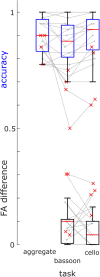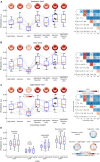Modulating Cortical Instrument Representations During Auditory Stream Segregation and Integration With Polyphonic Music
- PMID: 34630007
- PMCID: PMC8498193
- DOI: 10.3389/fnins.2021.635937
Modulating Cortical Instrument Representations During Auditory Stream Segregation and Integration With Polyphonic Music
Abstract
Numerous neuroimaging studies demonstrated that the auditory cortex tracks ongoing speech and that, in multi-speaker environments, tracking of the attended speaker is enhanced compared to the other irrelevant speakers. In contrast to speech, multi-instrument music can be appreciated by attending not only on its individual entities (i.e., segregation) but also on multiple instruments simultaneously (i.e., integration). We investigated the neural correlates of these two modes of music listening using electroencephalography (EEG) and sound envelope tracking. To this end, we presented uniquely composed music pieces played by two instruments, a bassoon and a cello, in combination with a previously validated music auditory scene analysis behavioral paradigm (Disbergen et al., 2018). Similar to results obtained through selective listening tasks for speech, relevant instruments could be reconstructed better than irrelevant ones during the segregation task. A delay-specific analysis showed higher reconstruction for the relevant instrument during a middle-latency window for both the bassoon and cello and during a late window for the bassoon. During the integration task, we did not observe significant attentional modulation when reconstructing the overall music envelope. Subsequent analyses indicated that this null result might be due to the heterogeneous strategies listeners employ during the integration task. Overall, our results suggest that subsequent to a common processing stage, top-down modulations consistently enhance the relevant instrument's representation during an instrument segregation task, whereas such an enhancement is not observed during an instrument integration task. These findings extend previous results from speech tracking to the tracking of multi-instrument music and, furthermore, inform current theories on polyphonic music perception.
Keywords: EEG; attention; auditory scene analysis; auditory stream segregation; envelope tracking; polyphonic music.
Copyright © 2021 Hausfeld, Disbergen, Valente, Zatorre and Formisano.
Conflict of interest statement
The authors declare that the research was conducted in the absence of any commercial or financial relationships that could be construed as a potential conflict of interest.
Figures







Similar articles
-
Assessing Top-Down and Bottom-Up Contributions to Auditory Stream Segregation and Integration With Polyphonic Music.Front Neurosci. 2018 Mar 7;12:121. doi: 10.3389/fnins.2018.00121. eCollection 2018. Front Neurosci. 2018. PMID: 29563861 Free PMC article.
-
Cortical tracking of multiple streams outside the focus of attention in naturalistic auditory scenes.Neuroimage. 2018 Nov 1;181:617-626. doi: 10.1016/j.neuroimage.2018.07.052. Epub 2018 Jul 24. Neuroimage. 2018. PMID: 30048749
-
The Right Temporoparietal Junction Supports Speech Tracking During Selective Listening: Evidence from Concurrent EEG-fMRI.J Neurosci. 2017 Nov 22;37(47):11505-11516. doi: 10.1523/JNEUROSCI.1007-17.2017. Epub 2017 Oct 23. J Neurosci. 2017. PMID: 29061698 Free PMC article.
-
Explaining the high voice superiority effect in polyphonic music: evidence from cortical evoked potentials and peripheral auditory models.Hear Res. 2014 Feb;308:60-70. doi: 10.1016/j.heares.2013.07.014. Epub 2013 Aug 3. Hear Res. 2014. PMID: 23916754 Review.
-
Functional imaging of auditory scene analysis.Hear Res. 2014 Jan;307:98-110. doi: 10.1016/j.heares.2013.08.003. Epub 2013 Aug 19. Hear Res. 2014. PMID: 23968821 Review.
References
-
- Alain C., Bernstein L. J. (2015). Auditory scene analysis: tales from cognitive neurosciences. Music Percept. Interdiscip. J. 33 70–82. 10.1525/mp.2015.33.1.70 - DOI
-
- Benjamini Y., Hochberg Y. (1995). Controlling the false discovery rate: a practical and powerful approach to multiple testing. J. R. Stat. Soc. Ser. B 57 289–300. 10.2307/2346101 - DOI
LinkOut - more resources
Full Text Sources

